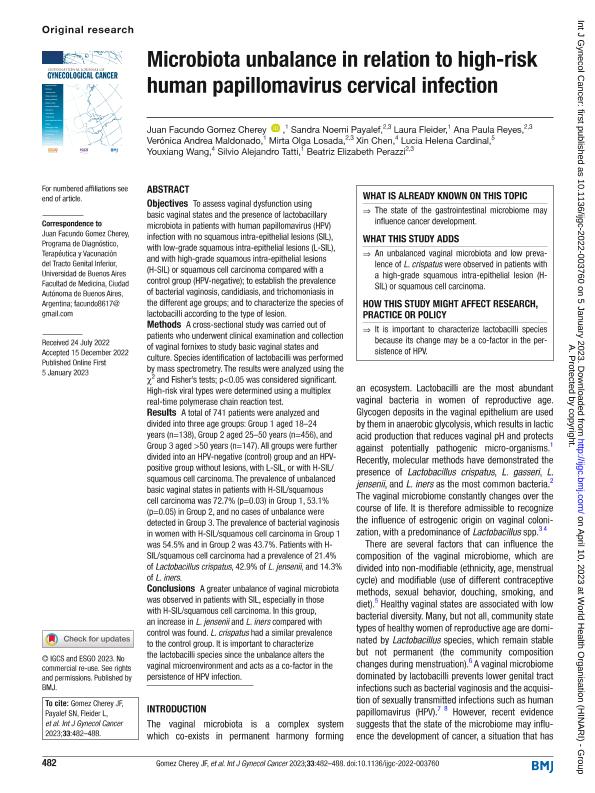Artículo
Microbiota unbalance in relation to high-risk human papillomavirus cervical infection
Gomez Cherey, Juan Facundo; Payalef, Sandra Noemi; Fleider, Laura; Reyes, Ana Paula; Maldonado, Verónica Andrea; Losada, Mirta Olga; Chen, Xin; Cardinal, Lucía Helena; Wang, Youxiang; Tatti, Silvio Alejandro; Perazzi, Beatriz Elizabeth

Fecha de publicación:
04/2023
Editorial:
BMJ Publishing Group
Revista:
International Journal of Gynecological Cancer
ISSN:
1525-1438
Idioma:
Inglés
Tipo de recurso:
Artículo publicado
Clasificación temática:
Resumen
Objective To assess vaginal dysfunction using basic vaginal states and the presence of lactobacillary microbiota in patients with HPV infection with no squamous intraepithelial lesions (SIL), low-grade squamous intraepithelial lesion (L-SIL) and high-grade squamous intraepithelial lesion (H-SIL) or squamous cell carcinoma compared to a control group (HPV-negative). To establish the prevalence of bacterial vaginosis, candidiasis and trichomoniasis in the different age groups and to characterize the species of lactobacilli according to type of lesion.Methods Cross-sectional study of patients who underwent clinical examination and collection of vaginal fornixes to study basic vaginal states and culture. Species identification of lactobacilli was performed by mass spectrometry. The Chi-square and Fisher´s test were used. p<0.05 was considered significant. High-risk viral types were determined using a multiplex real time PCR test.Results: A total of 741 patients were analyzed and divided into 3 age groups: Group 1, aged 18 to 24 years (n=138), Group 2, aged 25 to 50 years (n=456) and Group 3, aged over 50 years (n=147). All groups were further divided into HPV-negative (Control), HPV-positive without lesion, L-SIL, H-SIL/squamous cell carcinoma. The prevalence of unbalance basic vaginal states in H-SIL/squamous cell carcinoma was 72.7% (p=0.03) in Group 1, 53.1% (p=0.05) in Group 2, and no cases of unbalance were detected in Group 3. The prevalence of bacterial vaginosis in the H-SIL/squamous cell carcinoma in group 1 was 54.5% and in group 2 was 43.7%. Patients with H-SIL/squamous cell carcinoma had a prevalence of 21.4% of Lactobacillus crispatus, 42.9% of L. jensenii and 14.3% of L. iners.Conclusions: A greater unbalance of vaginal microbiota was observed in patients with squamous intraepithelial lesions (SIL), especially in H-SIL/squamous cell carcinoma. In this group, an increase of L. jensenii and L. iners compared to control was found. L. crispatus had similar prevalence to control group. It is important to characterize the lactobacilli species since the unbalance alters the vaginal microenvironment and acts as a cofactor in the persistence of HPV infection.
Palabras clave:
MICROBIOTA UNBALANCE
,
HIGH-RISK HPV
,
CERVICAL INFECTION
Archivos asociados
Licencia
Identificadores
Colecciones
Articulos(OCA HOUSSAY)
Articulos de OFICINA DE COORDINACION ADMINISTRATIVA HOUSSAY
Articulos de OFICINA DE COORDINACION ADMINISTRATIVA HOUSSAY
Citación
Gomez Cherey, Juan Facundo; Payalef, Sandra Noemi; Fleider, Laura; Reyes, Ana Paula; Maldonado, Verónica Andrea; et al.; Microbiota unbalance in relation to high-risk human papillomavirus cervical infection; BMJ Publishing Group; International Journal of Gynecological Cancer; 33; 4; 4-2023; 482-488
Compartir
Altmétricas



